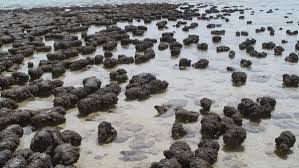Stromatolites : In News

A large stromatolites — dating back to 600 million years unearthed in the pine-clad ridges of Chambaghat in Solan district of Himachal Pradesh.
- Stromatolites are organo-sedimentary structures formed from the entrapment of calcium carbonate precipitates by algae and cyanobacteria.
- They are bio sedimentary structures produced in shallow marine seas.
- These structures are usually characterized by thin, alternating light and dark layersthat may be flat, hummocky, or dome-shaped.
- Stromatolites were common in Precambrian time(i.e., more than 542 million years ago).
- Most stromatolites are marine, but some forms from Proterozoic strata more than 2 ½ billion years old are interpreted as inhabiting intertidal areas and freshwater ponds and lakes.
- Living stromatolites are found in only a few salty lagoons or bays on Earth.
- The stromatolites at Chambaghat lie within the Krol Group of sedimentary rocks, comprising limestone, shale, and sandstone, formed in a shallow marine environment of what was once the Tethys Sea.
- This region was once part of Gondwana, the southern supercontinent that included India, South America, Africa, and others.
- The Indian plate’s northward drift and collision with Eurasia lifted marine sediments, including stromatolites, thousands of meters skyward.




